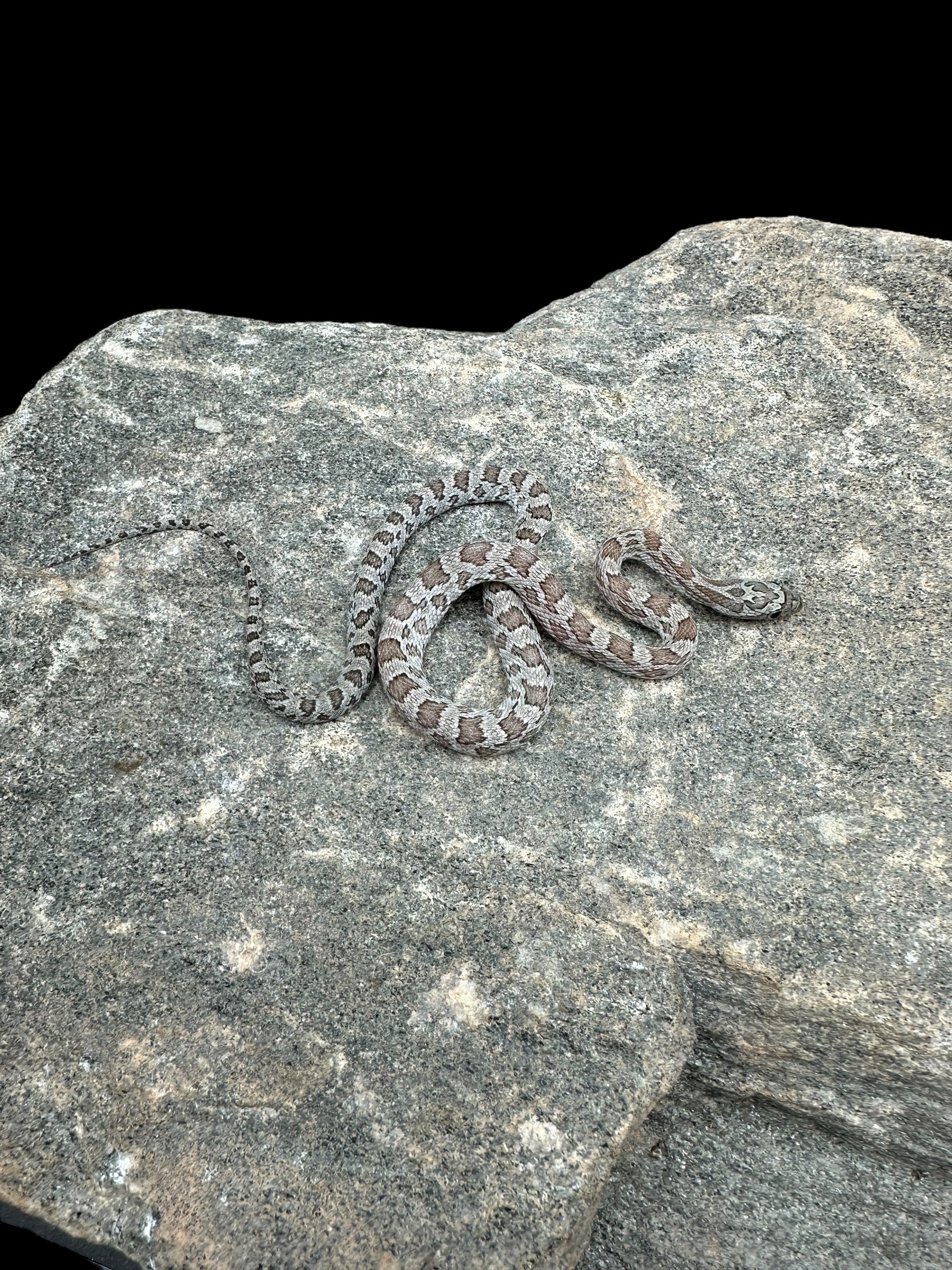Photo Disclaimer
Description
Corn Snake (Cinder)
Scientific Name: Pantherophis guttatus
Common Name: Corn Snake
Species Overview
Size: Adults typically reach 3–5 feet (0.9–1.5 m) in length, with a slender, agile body and smooth, glossy scales.
Appearance: The Cinder Corn Snake is a cool-toned, smoky morph known for its muted grays, silvers, and charcoals. This Corn Snake exhibits a gray base color overlaid with darker slate or gunmetal blotches that may develop subtle pink or mauve undertones with age. The eyes are dark red or burgundy, providing a striking contrast against the otherwise subdued color palette. The belly pattern is reduced and faded, with softened checkering that contributes to the morph’s clean, ghostlike appearance. Some individuals express faint lavender or rust hues depending on lineage and lighting. Overall, the Cinder Corn Snake presents a sophisticated, metallic look that distinguishes it from other grayscale morphs like Anerythristic or Charcoal.
Distribution: A selectively bred morph of the Corn Snake (P. guttatus), originally derived from lineages producing naturally ashy, desaturated coloration.
Habitat: Wild Corn Snakes inhabit pine forests, meadows, and agricultural areas throughout the southeastern United States. In captivity, they thrive in naturalistic terrariums with hides, climbing opportunities, and soft substrate for burrowing.
Behaviour: Calm, intelligent, and observant. Corn Snakes are crepuscular, most active around dawn and dusk. The Cinder Corn Snake retains the species’ relaxed temperament and consistent feeding habits, making it a reliable choice for both new and experienced keepers.
Captive Care
Enclosure: A naturalistic 40-gallon terrarium (36” × 18” × 18”) or larger is ideal for adults. A soil-based or bioactive substrate layered with leaf litter supports burrowing and exploration. Provide multiple hides, cork flats, climbing branches, and plant cover to promote natural behaviors and security.
Temperature & Humidity: Maintain a daytime gradient of 75–82°F (24–28°C) with a basking area around 86–88°F (30–31°C). Allow nighttime drops to 70°F (21°C). Keep humidity between 40–60%, with a humid hide provided during shedding.
Diet: Offer frozen-thawed rodents every 7–10 days for juveniles and every 10–14 days for adults. Prey should be approximately 1.25× the width of the snake’s mid-body.
Behaviour in Captivity: Calm, steady, and easy to manage. Corn Snakes adapt readily to naturalistic enclosures and handling routines. The Cinder Corn Snake’s refined appearance and muted tones make it an appealing display animal for collectors who appreciate subtle coloration.
Special Considerations: Cinder Corn Snakes often darken or develop richer tones with age. Moderate lighting helps maintain color vibrancy without washing out their natural contrast.
Genetics Note
Cinder (Recessive)
Reduces red pigmentation while enhancing gray, silver, and smoky tones. The gene also softens belly checkering and dorsal contrast, giving the morph a clean, subdued appearance. When combined with other traits such as Amel, Charcoal, or Diffused, Cinder contributes to pastel and ghostlike morphs with exceptional visual depth.
Genetic Combination Summary
The Cinder Corn Snake expresses a single visible recessive trait:
-
Cinder = Removes red pigment, replacing it with soft gray, silver, and charcoal hues
This gene creates a Corn Snake with cool, desaturated coloration and smooth contrast. The Cinder Corn Snake is admired for its subtle metallic beauty and is frequently used in breeding to produce pale, ethereal combinations such as Cinder Ghost, Cinder Amel, or Cinder Lava.

